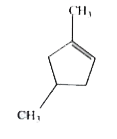A chloro compound(A) on reduction with Zn-Cu and ethanol give hydrocarbon (B) with 5 carbon atoms. When(A) is dissolved dry ether and treated with sodium metal it gave 2, 2, 5, 5 tetra methyl hexane. The treatment of A as A'C (in presence of alcoholic KCN)
The compound A is:
1-chloro-2,2 dimethyl propane
1-chloro-2,2 dimethyl propane
1-chloro-2 methyl butane
2-chloro-2 methyl propane
The correct Answer is:A
To solve the problem, we need to identify the compound A based on the given reactions and products. Let's break down the information step by step.
Step 1: Analyze the Reduction Reaction
The question states that a chloro compound (A) on reduction with Zn-Cu and ethanol gives a hydrocarbon (B) with 5 carbon atoms.
Hint: Look for a chloro compound that can yield a hydrocarbon with 5 carbon atoms upon reduction.
Step 2: Identify the Structure of Hydrocarbon B
Since hydrocarbon B has 5 carbon atoms, we can consider possible structures. The simplest structure with 5 carbons is pentane (C5H12) or its isomers.
Hint: Consider the possible isomers of pentane that could be formed from a chloro compound.
Step 3: Analyze the Reaction with Sodium Metal
The question also mentions that when compound A is treated with sodium metal in dry ether, it gives 2,2,5,5-tetramethylhexane. This suggests that compound A must have a structure that allows for coupling reactions to form this specific product.
Hint: The presence of multiple methyl groups in the product suggests that compound A should have branching.
Step 4: Deduce the Structure of Compound A
From the information given, we can deduce that compound A must be a chloro compound that can lead to the formation of 2,2,5,5-tetramethylhexane upon reaction with sodium.
A suitable candidate for compound A is 1-chloro-2,2-dimethylpropane (C5H11Cl). This compound has a structure that allows for the formation of the desired hydrocarbon upon reduction and coupling.
Hint: Verify if the structure of 1-chloro-2,2-dimethylpropane can lead to the desired products.
Step 5: Confirm the Structure
When 1-chloro-2,2-dimethylpropane is treated with sodium in dry ether, it can couple to form 2,2,5,5-tetramethylhexane. Additionally, the reduction with Zn-Cu in ethanol will yield a hydrocarbon with 5 carbon atoms.
Hint: Check the reaction pathways to ensure that the proposed structure of A leads to the correct products.
Conclusion
Based on the analysis, the compound A is confirmed to be 1-chloro-2,2-dimethylpropane.
Final Answer: The compound A is 1-chloro-2,2-dimethylpropane.
The question states that a chloro compound (A) on reduction with Zn-Cu and ethanol gives a hydrocarbon (B) with 5 carbon atoms.
Since hydrocarbon B has 5 carbon atoms, we can consider possible structures. The simplest structure with 5 carbons is pentane (C5H12) or its isomers.
The question also mentions that when compound A is treated with sodium metal in dry ether, it gives 2,2,5,5-tetramethylhexane. This suggests that compound A must have a structure that allows for coupling reactions to form this specific product.
From the information given, we can deduce that compound A must be a chloro compound that can lead to the formation of 2,2,5,5-tetramethylhexane upon reaction with sodium.
When 1-chloro-2,2-dimethylpropane is treated with sodium in dry ether, it can couple to form 2,2,5,5-tetramethylhexane. Additionally, the reduction with Zn-Cu in ethanol will yield a hydrocarbon with 5 carbon atoms.
Based on the analysis, the compound A is confirmed to be 1-chloro-2,2-dimethylpropane.
Topper's Solved these Questions
Similar Questions
A five C-atom hydrocarbon is formed by the reduction of a chloroderivative (A) of an alkane with Zn-Cu couple. (A) (A) is dissolved in dry ether and then treated with metallic sodium to give 2, 2, 5, 5-tetramethyl hexane. The IUPAC name of compound (A) is:
View SolutionChloro derivative of an organic compound 'X' on reduction with zinc-copper couple gave a hydrocarbon (C6H12). Ethereal solution of 'X' when heated with sodium gave 2,2,5, 5-tetramethylhexane. Identify the compound 'X'.
View Solution
Knowledge Check
- Question 1 - Select One
An alcohol (A) gives Lucas test within 5 min. 7.4 g of alcohol when treated with sodium metal liberates 1120 mL of H2 at STP. What will be alcohol (A)?
ACHCH2_3OHBCH3CH(OH)CH2CH3C(CH3)3OHDCH3CH(OH)CH2CH2CH3 - Question 2 - Select One
Which compound will yield 5-keto-2-methyl hexanal upon treatment with O3?
A B
B C
C D
D
The compound A on treatment with Na gives B, and with PCl5 gives C. B and C react together to give di Ethyl ether. A,B and C are in the order
View SolutionCH3CO2C2H5 on reaction with sodium ethoxide in ethanol gives A, which on heating in the presence of acid gives B compound B is
View SolutionWhich compound will yield 5-keto -2 methyl hexanal upon treatment with O3?
View SolutionCompound A (C6H12O2) on reduction with LiAlH4, yielded two compounds B and C. The compound B on oxidation gave D which upon treatment with aqueous alkali and subsequent heating furnished E. The latter on catalytic hydrogenation gave C. The compound D was oxidised further to give F which was found to be a monobasic acid (molecular) formula weight = 60. Deduce the structures of A, B, C, D and E.
View SolutionCompound A (C6H12O2) on reduction with LiAlH4, yielded two compounds B and C. The compound B on oxidation gave D which upon treatment with aqueous alkali and subsequent heating furnished E. The latter on catalytic hydrogenation gave C. The compound D was oxidised further to give F which was found to be a monobasic acid (molecular) formula weight = 60. Deduce the structures of A, B, C, D and E.
View SolutionMnO2 on reaction with dilute sulfuric acid gives
View Solution
